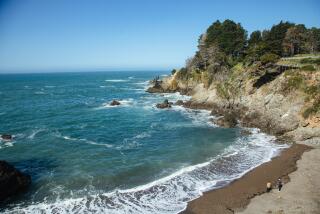Archeological Dig Helps Unravel Biblical Mystery
- Share via
As the housewife was fetching food from her pantry, the ground started shaking ominously. Storage containers began to fall off the shelves and sides of meat swung wildly on their hooks. Frightened, the woman turned to flee, but it was too late.
Chunks of wall stones began to fall, and the woman was crushed to death--one of hundreds, perhaps thousands, who died in a cataclysmic earthquake 3,000 years ago that leveled the ancient city of Dor on the Mediterranean coast of what is now Israel.
“It was very dramatic and very ugly,” said UC Berkeley archeologist Andrew F. Stewart.
The discovery of the woman’s crushed skeleton, reported this month by Stewart and other UC Berkeley researchers, solves a mystery that has long puzzled Biblical scholars.
According to the Book of Judges, Dor was one of three northern fortresses in Joshua’s time that were controlled by Phoenicians and that had not been conquered by Israelites.
But in 1 Kings, 200 years later, all three cities are said to be part of King Solomon’s dominion. Nowhere, however, is there a description of the major battles that would have been necessary in such a conquest.
The new discovery suggests that the devastating earthquake leveled Dor, making conquest no problem. “The door flew open--rather, it fell down--and David walked right in,” Stewart said.
The woman laid in her rubble tomb until last August, when Stewart’s colleague, archeologist Ranbir Sidhu, literally stumbled across her foot, sticking up from the rubble of an excavation at Tel Dor, 40 miles north of Tel Aviv.
“It’s a very significant discovery . . . because it may help to explain why that city didn’t have to be conquered,” said archeologist David Stronach of UC Berkeley. “It suggests that there could be other interesting finds just around the corner. . . . If there was a serious earthquake, there should be many more time capsules to be found in that very large site (Dor).”
Archeologist Oded Borowski of Emory University in Atlanta noted that a similar earthquake-buried skeleton dating from 3500 BC has recently been found at Tel Halif, northeast of Bar-Sheva. Bet She’an, near Tel Dor, was flattened by a quake in AD 745. Combined with the recent devastating earthquake in Egypt, Borowski said, “these discoveries remind us that this region is prone to earthquakes” and that those quakes can play a significant role in history.
Dor was a key location not only because of its natural harbor, but also because it was the end of a caravan route from the Middle East through Damascus and along the Sea of Galilee. It is also on a major north-south trade route.
Because of its key location, it has been occupied by many different groups, including Turks, Christian crusaders, Arabs, Romans, Maccabees, Greeks, Macedonians, Persians, Assyrians, Israelites, Phoenicians, Philistines, Sicels, Canaanites, Egyptians and possibly others.
Dor was originally a Canaanite town during the late Bronze Age (13th Century B.C.) until it was conquered by the Egyptians. Rameses II built a mighty fortress there, but it eventually fell to the so-called Sea Peoples, including the Philistines and the Sicels, who later gave their name to Sicily. The Phoenicians apparently displaced the Sicels about 1100 BC. The Israelites also attempted to take Dor about this time, but were unsuccessful.
Like previous archeologists who have excavated at the site since the 1920s, Stewart and his colleagues have successively dug down through the compacted dirt and debris representing each occupier. They were the first, however, to discover a skeleton, the only one to be unearthed from that era in Northern Israel.
“We don’t often find them (in northern Israel) because it tends to be moist and humid and even bones disappear,” said archeologist Victor Gold of Pacific Lutheran Theological Seminary. And after a catastrophe or a war, typically, dead bodies were removed and buried, he said. The skeleton found at Tel Dor, christened “Doreen” by the researchers, was not buried because the rubble hid her.
Telltale signs suggest that Doreen was crushed when the quake wrenched apart a six-foot-tall stone wall and caused it to tumble over her and a larder crammed with pottery. She was found lying on animal bones that may have been scattered before she fell.
The pottery found around her was of the distinctive Phoenician “bichrome” variety, with tones of blue-black and red on buff-colored clay. Archeologists have firmly established that this pottery was imported to the Israel coast just before 1000 BC., thus helping to pinpoint when Doreen died.
Stewart firmly believes that a military attack could not account for the destruction he discovered. “Large amounts of what would normally be loot--all sorts of goodies--are buried under the collapsed walls,” he said. “The evidence is fully compatible with that of an earthquake and seems not consistent with what we know happened when a city was sacked.”
Stewart’s team--which has been excavating for more than a decade and includes Berkeley students and as many as 50 American volunteers each summer--has found a variety of objects, including four-foot-tall Persian storage jars filled with olive remnants, thousands of Murex mussel shells discarded during the making of Tyrian purple dye, coins, tools, and tons of pottery shards from different eras.
They also have unearthed a Roman coastal road and a huge temple, as well as a “very large Persian building that we don’t understand yet, and some huge public buildings,” Stewart said.
There are mysteries remaining. Below Doreen’s level is evidence of another cataclysm.
“There is massive burned destruction in a layer that is five to six feet thick.. . . . It’s like the great San Francisco fire.”
The level “seems to be connected with the Sea Peoples,” Stewart said, “but we haven’t got enough yet to be sure what is going on.”
Volunteers for next summer’s dig can call Stewart at (510) 643-9040.
More to Read
Sign up for Essential California
The most important California stories and recommendations in your inbox every morning.
You may occasionally receive promotional content from the Los Angeles Times.










